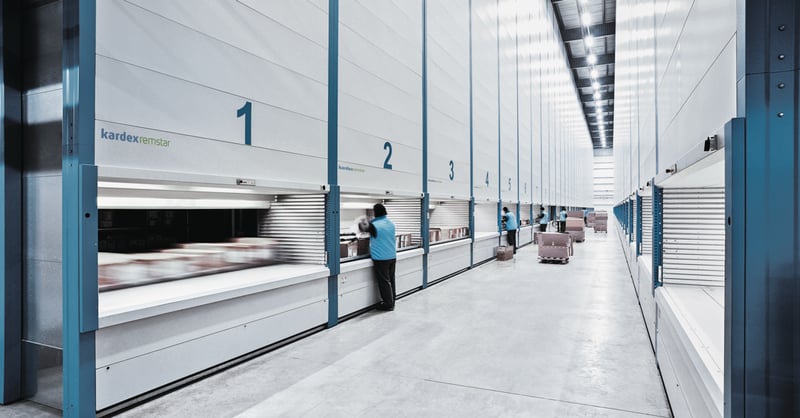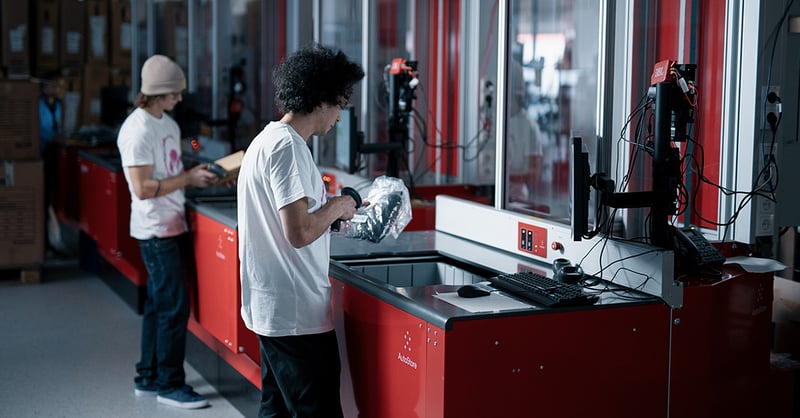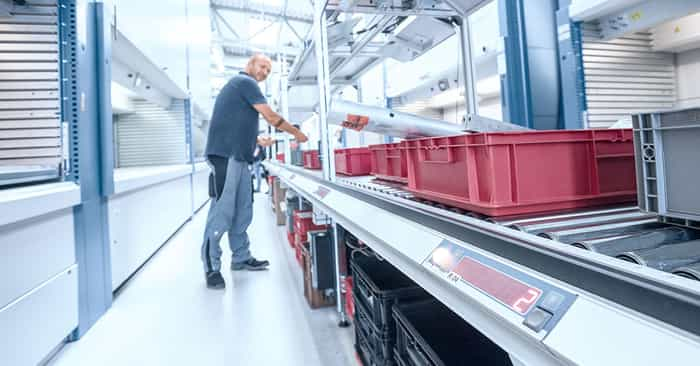*** Read our updated blog post on the latest Warehousing Trends: Warehouse Automation Trends for 2025: 25 Expert Thoughts ***
Last year put the supply chain at the center of the national conversation. Of the 200 US-based manufacturing executives Deloitte surveyed for their most recent supply chain report, 80% reported “heavy or very heavy impact on their supply chain by at least one disruption over the last 12–18 months” and 90% of surveyed executives reported “the frequency of these disruptions has increased over the last decade.” This report comes off the back of their 2021 survey, in which 72% of US-based manufacturing executives “predict that disruptions similar to the ones experienced during the pandemic will continue into the future.”
While the labor challenge is predicted to ease a bit in 2023, supply chain issues are predicted to continue and DCs are doubling down on automation to help. With 2023 ramping up, let’s review the warehousing challenges coming your way in 2023 – and more importantly some concrete actions you can take to be prepared.
1. “Just-in-case” is here to stay, for now at least
Experts are predicting ongoing supply chain disruption well into the mid- or even late-2020’s. With supply chain issues here to stay – so are “just in case” inventory strategies. Pre-Covid lean manufacturing and "just in time" inventory strategies were the best approach to stay competitive and avoid being cash-strapped with slow-moving inventory, but that’s no longer the case. To combat the challenges of the past 24 months (COVID, labor shortages and supply chain disruptions) most DCs have pivoted to a “just-in-case” inventory strategy.
While 2023 will see DC’s ease up on “buying any inventory they can get their hands on”, most will not transition back to a “just-in-time” inventory strategy just yet. With supply chains still fragile – flexibility will be the key to inventory management in 2023. DCs will error on the side of caution and continue to hold a bit more inventory than they need – leaving you to figure out how to accommodate that inventory in the short term (pro tip: automated storage and retrieval solutions can be a great solution!)
Action: With inventory shortages and supply chain issues set to persist, continue leveraging a flexible “just in case” inventory strategy to ensure you have the inventory you need to fill orders.
2. Labor shortages continue, spurring automation boom
The labor shortage is one of the most talked about topics in warehouses nationwide - the combination of retiring baby boomers (shrinking the labor pool), the explosion of e-commerce (putting more pressure on the DC) and the lasting impacts of COVID (less workers able/willing to work) has made labor the number one challenge for DC’s year over year. According to the U.S. Department of Labor’s (DOL) Bureau of Labor Statistics (BLS) after the onset of COVID unemployment peaked to 15.7% in summer 2020 within the Warehousing and Storage sector. Last year this sector saw unemployment drop to just over 4% – on par with 2019 levels. Not only was labor harder to find in 2022, costs increased. The BLS reported labor rates have risen ~23% in 5 years with the mean hourly wage of $18.39 and a mean annual wage of $38,260 (neither of these numbers are fully burdened).
The outlook for labor in 2023 is uncertain. Some experts are saying unemployment might hold at just over 4% in 2023, others are predicting an increase to over 6% because of inflation. Either way, DCs are doubling down on automation to reduce their reliance on manual and unpredictable labor. Shifting to automation helps warehouses insulate themselves from the fluctuating labor pool, while overall increasing performance.
Action: In order to reduce reliance on manual, unpredictable labor, turn to automated solutions that directly address labor challenges.

3. Distribution Centers carry on embracing the urban lifestyle
It’s 2023 and same-day delivery is now a basic expectation for urban customers. To match these heightened demands, many retailers are adapting and getting closer to the urban customers – literally – by investing in DCs in urban areas.
It’s a two-part approach. On one hand, companies are building completely new DCs in densely populated urban areas. In doing so, they will be able to have products delivered via local delivery vehicles the same day at a lower cost long term. On the other hand, DCs are going to continue the trend of utilizing existing brick and mortar store locations for fulfillment in 2023. These converted retail spaces offer many of the same benefits as brand-new DCs, often at a lower up-front cost.
Action: Be creative when planning for the future and consider urban DCs to promote ongoing growth and manage rising customer expectations.
4. Optimizing floorspace is no longer optional
North American warehouse space has never been so scarce and so expensive. The Cushman and Wakefield Marketbeat Report reveals the U.S. industrial vacancy rate fell to an all-time low (3.2%) in 2022 while industrial rent reached an all-time high of $8.36/square foot . The outlook for 2023 isn’t much better as vacancy rates are expected to remain under around 4% throughout 2023 while rent continues to creep up. Building new isn’t much better as the demand for new industrial space will continue to outpace supply throughout 2023.
Rising costs, low vacancy rates and insufficient new industrial space will see DCs continue to double down on the “building up” trend that accelerated in 2022. Automated storage solutions that utilize the full floor to ceiling height are allowing DCs to fit more inventory in drastically less floorspace.
Action: Build up – not out – and get away from over-priced and under-utilized floorspace using automated storage and retrieval technologies.
5. 3rd party warehousing will continue to grow
While space troubles remain at the forefront of warehouse managers’ minds, 3rd party or on-demand warehousing will continue seeing an uptick in 2023, especially in urban areas. 3rd party warehouses offer a unique opportunity for businesses to store more inventory – helping facilitate a “just in case” strategy – and manage increased growth, while avoiding the risk associated with a permanent space expansion. Not only will DCs be able to store more inventory with 3rd party warehouses, they’re also able to store their inventory in more locations, allowing companies to own more of their own supply chain.
Action: Explore 3rd party warehousing to expand inventory on-hand in specific locations while avoiding expensive property investments.
6. Return troubles set to return in 2023
By now most people have heard the stat, “at least 30% of all products ordered online are returned,” but that number is 21% higher than the return rate at brick and mortar stores. Like it or not, the explosion of e-commerce shopping spurred by the pandemic has fundamentally shifted customer expectations on returns, and those expectations are here to stay.
Returns have proven to be such an issue that major retailers have seriously dramatic return policies – as in “don’t even worry about returning it, here’s your refund” dramatic. In order to remain competitive, retailers and DCs must be ready to handle returns and invest in their reverse logistics processes, else they’ll continue to eat losses at further increasing rates as e-commerce continues to grow.
Action: Get ahead now and establish a smooth reverse logistics program now – to avoid bleeding money in the long term.

7. Goods-to-person robotic integrations continues to rise
In response to labor shortages and increased customer demands, robotics adoption in warehousing rose exponentially in 2022 and is set to continue rising in 2023 and beyond. By 2025, up to 50,000 robotic warehouses will potentially be developed, while 8 million robots may be shipped to users by 2030. Distribution centers will continue to explore the use of order fulfillment robotics – such as robotic cube storage and autonomous mobile robots (AMRs) – in the warehouse in 2023. Further, DCs will look to use cobots (collaborative robots that can work alongside humans) in combination with a space saving automated storage and retrieval system to maximize efficiencies.
Action: Don’t be intimidated by robotic solutions – they are intuitive, adaptable and scalable to a variety of DC applications and easier to cost justify than you might think!
8. Millennials continue rising in the ranks of DC leaders
In 2023, expect even more millennials in leadership positions at DCs across the country as they begin to reach their peak earning years. They continue to boast impressive higher education and master’s degree rates, most holding these degrees at rates of roughly 60 and 30%, respectively, according to a survey by Peerless Research Group. This level of education has accelerated millennials into leadership positions faster than anticipated. Known for their adaptability and willingness to invest in new technologies, expect DCs to further embrace automation, robotics, WMS, wearable technologies, blockchain and IoT as millennials become decision-makers in the warehouse.
Action: Continue hiring within and trusting the younger talent in your organizations – their unique perspective and willingness to try new technologies are the future of warehousing.




